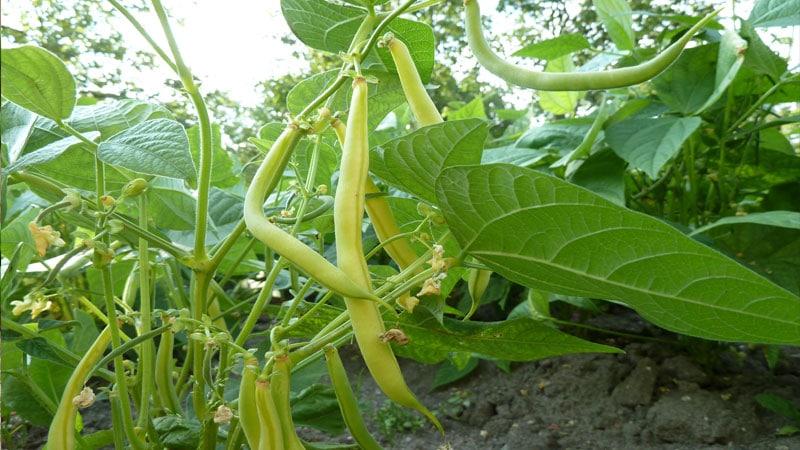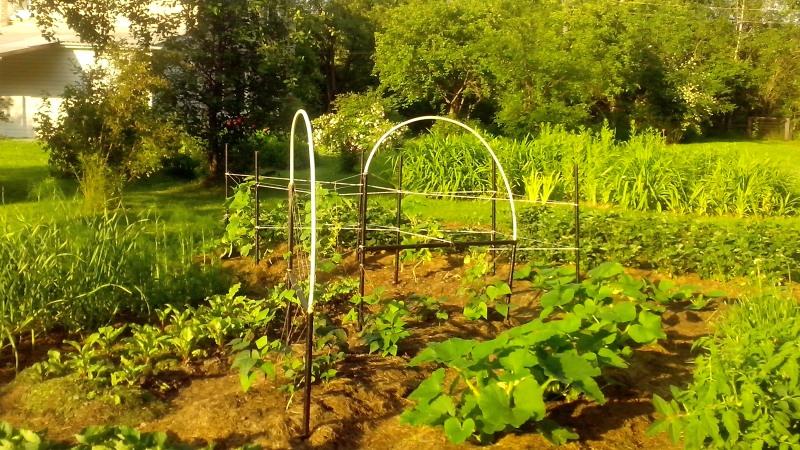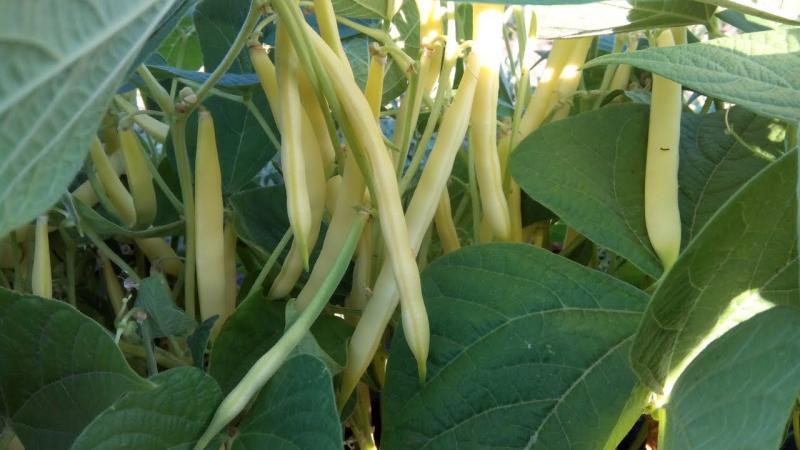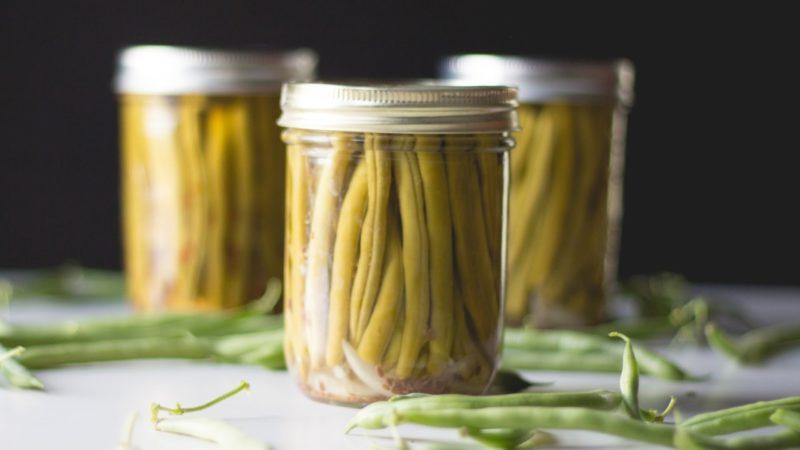What kind of asparagus beans to grow: varieties that will not leave anyone indifferent
Asparagus beans - a real storehouse of vitamins and useful elements. It is eaten as a daily product, included in diets and health-improving diets. Some people buy beans in a supermarket or market, others prefer to grow them on their own.
Consider what varieties of asparagus beans exist and analyze their benefits.
The content of the article
Types of asparagus beans
The varieties of asparagus beans are as follows:
- Bush... One of the most favorite plants of gardeners. It is grown simply, the seeds are large, the seedlings appear quickly. Plants do not need thinning. The main trick to watering regularly and abundantly is that bush beans like a lot of water. Natural approvals must be applied: herbal infusions and ash. This plant is also to the liking of lovers of aesthetics in the garden - the bushes grow compact, the beds look neat and well-groomed. The leaves of the bushes are of a pleasant light green color.
- Curly... This variety of beans will perfectly decorate a garden or home, since it has long curly vines. The pods are long and flat. The taste is tender. Curly varieties are more productive than bush varieties, plus they are lighter and more interesting in taste. It is best to plant these beans in a sunny, windless place. Before planting, be sure to fertilize the soil with humus or compost.
- Fiber free... This species is appreciated for its high yield - many pods grow on one branch. Fiber-free beans are prized in cooking because they are great for freezing and are used in preparation many dishes. The fruits are picked while they are green, otherwise they will become hard and lose their taste.
- Vigna... The beans of this variety are narrow, long and light. They need to be consumed at a tender young age. Beans contain a lot of vitamins A, B, mineral salts, calcium and iron. Vigna loves warmth. The best thing plant first seedlings, and then move the beans to open ground. Special care is not required for her, she perfectly tolerates shade. In Russia, it is best to grow such beans in a greenhouse.
- Sugar... One of the most delicious types of beans. It is actively used in food preparation; a lot of tasty and healthy dishes are prepared from it. The peculiarity of sugar varieties is the absence of coarse fibers, which is why its taste is delicate and pleasant.

Review of the best varieties of asparagus beans
Let's consider in detail the most popular varieties of asparagus beans.
Blauchild
A plant with long purple pods. After cooking, the pods turn dark green in color. The bush reaches 3-4 m in length, requires support and overseeding. "Blauhilda" has an excellent taste, which is why it is actively used in canning, freezing, cooking side dishes and salads.
Vigna
This variety got its name in honor of its ancestor, Italian Domenico Vigny. It has three forms: bush, semi-bush and curly. It grows mainly in warm climates, so it is not yet very popular among our gardeners.
Beans are a valuable dietary product - they are high in protein and starch.
Oil king
Early maturing variety. It grows in compact bushes in a garden bed, reaching a maximum height of 40 cm. It tolerates drought well and is resistant to diseases.The beans are light yellow in color. Harvesting is possible in the early stages of ripening. Beans have a delicate taste. Long-term heat treatment is not required.
Blue Lake
The green pods are up to 16 cm long and contain small white seeds inside. Due to their high growth, the bushes of the Blue Lake need constant support. Like the Butter King, this variety is resistant to infections and various diseases.
Vigna Countess
Refers to curly varieties. The bushes continue to grow and bear fruit even after the first harvest. Variety Countess is distinguished by a fast ripening rate, reduced fiber, resistance to low temperatures. However, it is best to plant it warm, after working on the seedlings.
Ash or chalk is perfect for feeding. Water in moderation.

Sweet courage
This variety is best planted from mid-May to early June. The first shoots appear within 7 days after planting. Sweet courage requires special attention in the heat - do not forget to water the plant regularly. Also remember that this species does not like nitrogen fertilizers.
The beans grow quickly, you need to collect more young pods. If this is not done, the culture will lose its taste.
Purple lady
The height of the bush reaches a maximum of 150 cm, the length of the pods is 15 cm. From other varieties, the Purple Lady has a higher yield and beautiful shoots. The plant is decorated with purple flowers, which gives the beds an interesting look. The beans are white.
Vigna Macaretti
Refers to semi-bush varieties. No special care conditions are required. The main thing is to weed the beds in time and loosen the ground. Good predecessors for this variety are cabbage, cucumbers, potatoes.
Harvesting begins approximately 45 days after the first shoots appear.
Gold mine
Feature of the variety - very sweet fruits... It ripens within 55 days and gives an excellent harvest. About 1 kg of beans are harvested from one bush.
Golden nectar
Since the bushes are powerful, support is needed. Beans up to 25 cm long, juicy and soft. They have a yellow-golden color. They have high nutritional properties. Sown in late May or early June, as the culture is sensitive to frost.
A good planting site is a well-warmed and moderately moist soil. Timely weeding and loosening are required from care.
Pencil Pod Black Wax
Unusual beans, first appeared in Italy. Bushes reach 40 cm in height. The fruits are well stored and transported. During transportation, the appearance of plants does not deteriorate. Inside the yellow pods "live" beans of black glossy color.
Red podded asparagus
Very beautiful beans - the bushes are decorated with a lot of long purple pods. They grow long, can reach 80 cm. Gardeners advise to eat asparagus, its length is about 0.5 m. The plant has a delicate and juicy taste.
Kentucky blue pole
This beans found particular recognition in the United States - Americans love them for their sweet taste and rich harvest. Refers to climbing crops, has tall and vigorous bushes... We recommend planting near fences or trees, be sure to tie them up.
The length of the green pods reaches 20 cm. The beans endure bad weather and other unfavorable factors. Many gardeners compare the Kentucky Blue Pole to the Blue Lake variety.

Pearl Queen
It grows in 50-55 days from the date of planting. The name speaks for itself - wavy purple pods will decorate any garden area. The variety is resistant to various diseases and viruses. In addition, the advantages of Pearl Queen include excellent taste and high commercial quality.
Fiery red
She is Turkish Beans and Winner. The culture blooms from June to frost. It has long fruits with white, black, pink or brown seeds. Grows in full sun or partial shade.
It is advisable to feed it with nitrogen fertilizers in the first month.Growing quickly, the fruit can be used both for cooking and for decorating the garden.
Pensil Pod yellow asparagus beans
Refers to yellow beans. The pods are about 20 cm long. The seeds are small, black. Suitable for both freezing and fresh consumption. Like other varieties, it tolerates bad weather.
Sachs without fiber
The bush reaches a height of 30-40 cm. The beans have a juicy taste with a high sugar content. The plant requires warmth and sufficient soil moisture. Does not tolerate weeds and soil in the shade.
The fruits are rich in minerals and vitamins of groups A, B. Mature seeds contain 20% protein. Great for diet food.
Bona
Refers to mid-season varieties. Seeds of white color with a slight sheen, are appreciated in cooking. The germination period is 50-60 days. Bona will provide the grower with a stable and rich harvest. No special care is required.
Bergold
The beans have an incredibly delicate flavor. White grains can be consumed both ripe and at the ripening stage. Bergold favors nutritious soils. Sowing names is best in early June.
Support the plant and weed and loosen regularly. Harvesting is done as the beans ripen.

Flamingo
The name corresponds to the appearance of the beans: red-pink grains are pleasing to the eye. Refers to early maturing crops. The variety is unpretentious, has a good yield anywhere. It is rich in vitamins and can be consumed fresh or frozen.
Vigna Fakir
A valuable dietary product, as it contains a large amount of protein. Fruit can prepare for the whole year. Excellent tolerance to dry air and shade. Good predecessors of the variety are cabbage, cucumbers.
It is best to provide the beans with support and fertilize the soil after the first buds appear. Harvested 40 days after germination.
Gina
An early variety of dwarf beans. The flat pods shimmer with a pale green color. The beans do not lose their valuable qualities during the long harvesting season. Perfect for canning. These beans are very easy to harvest.
Crane
Asparagus bush plant, reaches 45-50 cm in height. Smooth green beans are 12 cm long. Sometimes the bean's "nose" is sharp or blunt. It is recommended to plant Zhuravushka in a new place every year to protect it from diseases. It is also recommended to maintain a sufficient level of soil moisture. If not enough, the beans will be small and coarse.
Paloma
Great for early and late sowing. The pods are dark green, about 11 cm long. The culture is resistant to viral diseases. Gives a stable good harvest. Used in food in any form.
Vigna Spaghetti
A productive, unpretentious and nutritious variety. Sowing is done in soil or soil in mid-May. Fruiting before the onset of frost. In terms of protein content, it is located between meat and fish, it has excellent nutritional properties. It can be boiled, fried, canned - the beans will not lose their taste.

How to choose a variety
From such a variety of varieties, choosing the best is not easy. The beans themselves have a huge amount of nutrients, they can be used in any form. Most varieties do not require special care, which greatly simplifies the growing process.
The most versatile varieties are Butter King, Sachs and Bona. They are distinguished by an abundant number of fruits and a universal purpose. Their bushes are resistant to viruses and diseases. You can eat beans in any form.
The varieties are great for people who follow a diet. Semi-sugar varieties should also be mentioned separately. The whole beans are eaten at the stage of milk maturity. They ripen well in the open field.
If you value not only nutritional qualities, but also appearance, then curly varieties are perfect for you. Such a plant will decorate your home, garden, gazebo, porch. Green shoots and delicate flowers hide unsightly walls. Experienced gardeners advise paying attention to varieties such as the Purple Queen, Golden Nectar and Blauhilda.
Important! Shrub beans require less space and do not require tying. The varieties Flamingo and Zhuravushka are especially distinguished from them.
Conclusion
The planting procedure for all types of beans is approximately the same: seedling preparation, planting in the soil in May-June, harvesting after 50-60 days. The beneficial properties of the culture are remarkable: it contains vitamins, proteins, and minerals. This is why beans are popular with many.
Remember that the plant does not like a lot of water, but it does great in moderately moist soil. Tall bushes must be tied up. You can eat beans in any form - they go well with meat or other vegetables.